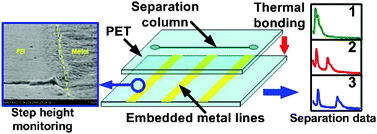Development of inlaid electrodes for whole column electrochemical detection in HPLC
Abstract
An electrochemical microfluidic device has been fabricated on PET (polyethylene terephthalate) substrate using an imprinting method. The imprinting transfers patterns from a stamp into a substrate mechanically. However, a blanket mould imprinting process has been introduced to embed the photolithographically produced gold metal electrode lines into the PET substrate resulting in an individually addressable array flush to better than 100 nm. The device formed one wall of a packed chromatography column. The array was electrochemically characterised using standard redox probes in both stagnant conditions and under flow. Both numerical modelling and


 Please wait while we load your content...
Please wait while we load your content...